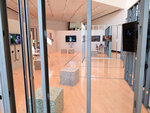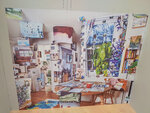

The Michigan State University Broad Art Museum sits on top of what used to be called a practice house — an apartment where, in the early 1900s, women in the home economics major lived in six-week rotations to practice the arts and sciences of homemaking.
Michigan Agricultural College, now MSU, was founded in 1855 to teach men to farm, but in 1870, 10 women enrolled and fully participated in all the courses and practical labor. Then, around the turn of the century, the college began to offer the women’s program, which formally became the home economics major in 1909. It offered coursework in textiles, food, nutrition, chemistry, design and financial management. According to the MSU Libraries website, these courses prepared women for careers outside of homemaking or farming, such as dietetics, design, teaching, management and healthcare.
The Broad’s exhibition “Shouldn’t You Be Working? 100 Years of Working from Home,” on display through Dec. 17, explores what it has meant for women to work from home for the last century via archival photos from the museum’s collection and excellently curated contemporary art on the themes of home, work and migration. Broad exhibitions are usually very tight — the gallery, art, furniture and lighting all feel like they’re working together. But this one is disorienting. It woke me up and made me want to know what I had just walked into.
The conflict between industry and domesticity is immediately and firmly established at the entrance of the exhibition with the piece “Womanhouse,” by Angela Washko, whose “female artificial intelligences respond to their captive domesticity.” A large video projection of a “The Sims” video game shows women trapped and isolated, working and taking care of basic human needs. The only seats for visitors are harsh foam blocks that look like they were pulled out of a warehouse.
The exhibition space is framed in a one-to-one scale of the old practice houses. Without walls, these small frames feel like walking among ruins, a quiet memorial to the past. Is this exhibit bringing history to life or asking it to be put to rest? I observe college-aged women wandering through, and I think of something I once saw on a dating app: “Seeking a traditional woman.” What does that even mean? What would it mean to a woman 15 years younger than me?
There’s an image of a homemaker, a stay-at-home mother, that we can conjure up in the popular imagination. But where did it come from? On the other side of the exhibition space, archival photos from the School of Home Economics demonstrate a myth in the making.
“They’re super staged,” associate curator Teresa Fankhänel said. “They’re trying to elevate the homemaker. They’re trying to show that this isn’t just a housewife who’s bored and has to be occupied — this is a professional. It’s someone who knows what they’re doing.”
But for Fankhänel, that image of domestic bliss was just a starting point — a marketing photo, even. More broadly, she said, schools of home economics allowed women to question their futures.
“The home is the starting point, but then you can leap out and do everything, anything you want to,” she said. She called the practice houses “a rehearsal space for the future” and said she hopes the exhibit sparks questions like, “Who do I want to be? How do I want to live and work? Is it the way I live and work right now? Am I happy the way it is?”
One installation, “Cream Screen,” by Marisa Olson, presents a picture-perfect, Instagram-worthy home office, complete with easy-care houseplants, a sleek desk and a blinding ring light. Much like the women posing at their work 100 years ago, “Cream Screen” is a performance of work and life. The COVID-19 pandemic brought office aesthetics into many of our homes, and Olson’s work explores how Zoom backgrounds, whether real or digital, are “an attempt at professionalizing the home and hiding what makes it private.”
The curatorial note on the exhibition does well in contextualizing home economics and the sort of homemaking displayed in the archival photos as a primarily white, middle-class undertaking until well into the postwar years. Women have always worked, though — inside or outside the home. And some have worked harder than others.
Guanyu Xu’s three pieces of digital art are my favorite part of the whole exhibition. These chaotic collages depict the disorienting experience of “home” through the eyes of immigrants and provide a powerful foil to the notions of “simplicity” that too often accompany our notions of domesticity. The way Xu distorts the size and distance of objects makes sense to me. They’re much more familiar to me as a representation of home than any imagined memories of softly folding flour into eggs or hanging clothes to dry on a line.
As I reflected on the exhibition later, it made me think about my maternal grandmother, who spent much of her long life carrying a union card for the Teamsters Union in Detroit. When I was about 19 years old, I was chatting with her, worried about what I should do after community college. She looked me in the eyes and offered me her sage wisdom.
“I never had any idea of what to do with my life, either,” she said.
A history of women’s work is also a history of our ambivalence, coping mechanisms and humor. There is plenty for our community to explore. “Shouldn’t You Be Working” illuminates moments of women’s labor from the past 100 years that aren’t what they appear as well as modern work-related realities that reach out to us with urgency, leading viewers to ponder all that came before our Zoom backgrounds — and what still lies beyond them.
Support City Pulse - Donate Today!
Comments
No comments on this item Please log in to comment by clicking here